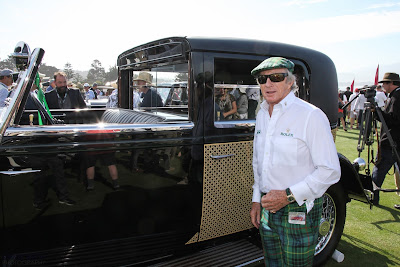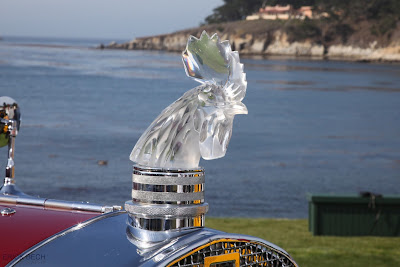 |
1930 Bugatti Type 46 Cabriolet
|
 Sure, you’ve been to a few automotive museums. You love the Petersen and its diverse collection of hundreds of cars in more than 100,000 square feet, plus its semi-exclusive basement vault.
Sure, you’ve been to a few automotive museums. You love the Petersen and its diverse collection of hundreds of cars in more than 100,000 square feet, plus its semi-exclusive basement vault. This is not that kind of museum.
In fact, this may be unlike any other car museum in the country. The Mullin Automotive Museum, established in 2010, is borne of one man’s passion for a specific subset of cars. The good news is, it’s a spectacular subset.
Peter Mullin’s collection consists largely of French automobiles from the Art Deco period of the 1920s and ‘30s, though the museum is actually about more than just cars. The interior décor of the Mullin reflects the aesthetic of this glamorous age, with even the elevator festooned in period-reflective ornamentation – though the building happens to be fully modern, with solar roof panels and a LEED Gold certification.
And the collection even includes period art and furniture, plus a bar reclaimed from 1920s-era Chicago, so you can imagine the barkeep sliding an illicit cocktail across it toward Al Capone himself.
This commitment to the many aspects of the era led Autoweek magazine to rate the Mullin as one of the top five automotive museums in the country in 2012.
The museum unveiled its Cars & Carriages exhibit two weeks ago, high- lighting the transition between horse power and “horsepower,” including a celebration of the commonality between the two eras that stems from the coach-building tradition of early automobiles. The very same craftsmen who assembled horse-drawn coaches before motorization lent their workmanship and styling touch to the new “horseless carriages.”
In light of this occasion, I headed down to Oxnard with my friend Jason Austin, a Santa Barbara-area farrier (he gives horses their fancy footwear), for a tour of the museum led by head docent Warner Hall.
Hall started with a little background on Mullin and his collection. While there are only around 50 cars on display in the building, Peter Mullin’s assemblage comprises more than 150 cars, many stashed in various storage facilities around the county. He also chairs the board of directors at the Petersen, so Mullin – the man – is one of the leaders of the community of enthusiasts who strive to protect the world’s automotive heritage.
This extensive collection allows for some great variety, even within the narrow category that he has embraced, so Hall says that whenever he’s away from the museum for any period of time, he always looks around for “what’s left and what’s new,” after regular collection rotations.
The first car that he chose to highlight is the oldest motorcar in the Mullin collection, a 1902 Panhard & Levassor Type B1, which Hall called “the Start of the Art.” This car, and its “Système Panhard”, provided a new formula for automotive layout, with the front-mounted engine driving the rear wheels. It also had a steering wheel rather than a tiller, and a pedal and gear level layout that would make it much more familiar to modern drivers than other cars of its age.
This particular car was restored about a quarter-century ago, and it won the prestigious Charles A. Chayne Trophy at Pebble Beach last year, which celebrates vehicles with the most advanced engineering for their particular era.
Hall pointed out many of the other cars in the collection from various historic French brands, such as Voisin, Delahaye, Talbot-Lago, and Hispano- Suiza (this one doesn’t sound French, but the company started producing its most extravagant models in Paris in the early 1900s). Many of the most valuable models, however, hail from that most storied Italian-cum-French brand, Bugatti.
In fact, Mullin has a great relationship with the Bugatti family, says Hall. The company itself is, of course, now under the control of the Volkswagen empire, but the family are still stewards of their own legacy.
 |
From the salon, one can survey the entire museum
|
That artistic family tradition drove Ettore to incorporate into his cars some of the most beautiful design in the automotive world, and the marque is still celebrated for its stunning aesthetics.
One of these stunners that Hall pointed out was the Type 46 Cabriolet, ornamented with such detail that even its powerplant is adorned with an engine scraping technique that, he says, required “a bazillion hours” of work, despite being a relatively invisible part of the design.
This car is a great example of Mullin and his wife, Merle, not only restoring their cars to full glory, but also customizing them with flourishes that, while not original, are in keeping with the type of design work that would have been executed in their heyday. The couple had the T46 upholstered with a custom woven deerskin that complements the wood-festooned dash beautifully.
And the Mullins will go to extremes sometimes to realize their design vision on a car. Hall even recounted a story of Mullin buying an entire herd of buffalo to be able to upholster one of his Hispano-Suizas with the rare hide.
Some of the more stunning sights in the museum are cars for which the word “patina” is a vast understatement. Tucked into the rear of the hall is a row of unrestored cars from the Schlumpf reserve collection, a haul of vehicles seized by the French government from a couple of bankrupt textile magnate brothers.
Around the corner sits “The Lady in the Lake”, a 1925 Bugatti Type 22 Brescia that had resided at the bottom of an Italian lake for 75 years. Much of the car had melted away by the time it was raised, but when they drilled into the engine to ensure there wasn’t water sloshing around inside, they found a crankcase full of the original oil, said Hall.
I could fill countless more pages with the wonders that abound at the Mullin, but instead I advise you to check it out yourself. Although make sure you plan ahead. The museum is open only two Saturdays per month, and you must buy tickets ahead of time. The tickets are $15 – with various discounts available – and the views are priceless.
Visit mullinautomotivemuseum.com for schedule information and to buy tickets.
And the Mullins will go to extremes sometimes to realize their design vision on a car. Hall even recounted a story of Mullin buying an entire herd of buffalo to be able to upholster one of his Hispano-Suizas with the rare hide.
Some of the more stunning sights in the museum are cars for which the word “patina” is a vast understatement. Tucked into the rear of the hall is a row of unrestored cars from the Schlumpf reserve collection, a haul of vehicles seized by the French government from a couple of bankrupt textile magnate brothers.
Around the corner sits “The Lady in the Lake”, a 1925 Bugatti Type 22 Brescia that had resided at the bottom of an Italian lake for 75 years. Much of the car had melted away by the time it was raised, but when they drilled into the engine to ensure there wasn’t water sloshing around inside, they found a crankcase full of the original oil, said Hall.
I could fill countless more pages with the wonders that abound at the Mullin, but instead I advise you to check it out yourself. Although make sure you plan ahead. The museum is open only two Saturdays per month, and you must buy tickets ahead of time. The tickets are $15 – with various discounts available – and the views are priceless.
Visit mullinautomotivemuseum.com for schedule information and to buy tickets.






















